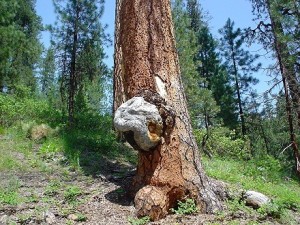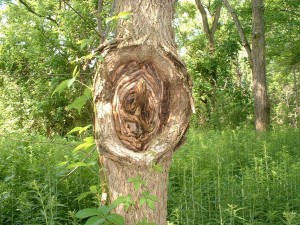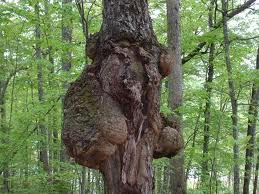Wood Infestation
How it affects Driftwood Sculpture
Most wood anomalies that would degrade the use of infested wood in logs for construction and veneers are just a beautiful boon for the wood artist Those wonder exceptions are the burls, cankers, and galls that lend such artistic beauty to many of our sculptures. Let’s explore what causes these aberrations and how we should look for and work with them.
Burls
Wow, what wonderful woods! Just check with our first place winners. Most of those sculptures are the result of very hard work on burls. The reason they all had to work so hard is the wood of a burl is contorted and hardened by the wild growth that causes them.
 A few of the most notable sculptures are Jeannette’s “Pilchuck
A few of the most notable sculptures are Jeannette’s “Pilchuck
Beauty,” Sam Matthew’s “Cumulus” and Chadd Hass’s “Big Eye.” Burls are created by a wildly abnormal growth that affects the grain or by aborted bud growth called a “bird’s eye” creation. These growths are evidenced as an enlarged bulge in the trunk or older branches of a growing tree and have a great value because of this particular growth and appearance. Large burls of the California Laurel, Northern red oak, or Black Walnut are used as a veneer in finer furniture. The Big-leafed Maple is the best burl factory in our area. Wavy, curly or bird’s eye burl may contain rotted bark, twig knots and even boring insect channels. Though burls are considered a log grade defect, we sure search them out for their beauty and they have great monetary value for the finder. Since there is not really infestation as the cause, burls are relatively safe to work. Still a mask should always be worn when working with a burl.
Cankers
A stem canker is a localized necrotic lesion made up of bark and cambium and caused by a fungi that affects wounds. There are many ways that this fungi  will infect a tree; frost, sun scald and other injuries will provide entry for this decay fungi. Since this canker can infest about 126 hardwood species lumber wood losses are estimated at 185+ million board feet a year. The presence of conks (decay caused by fungus visibly fruiting in the body of a tree) indicates excessive heart rot. This infestation will extend upward and downward from the cankered area. Since the internal damage is often more extensive than the external signs this wood has no commercial value. A canker and any massive rot is not included in a log.
will infect a tree; frost, sun scald and other injuries will provide entry for this decay fungi. Since this canker can infest about 126 hardwood species lumber wood losses are estimated at 185+ million board feet a year. The presence of conks (decay caused by fungus visibly fruiting in the body of a tree) indicates excessive heart rot. This infestation will extend upward and downward from the cankered area. Since the internal damage is often more extensive than the external signs this wood has no commercial value. A canker and any massive rot is not included in a log.
Galls
 Galls are greatly pronounced modification of woody tissue. These are seen on tree branches, stems, tree trunks and roots. These tumors on woods are caused by alien organisms like bacteria, fungus and insects. Like a true burl, these growths are a product of excessive cellular growth and over growth of ingrown bark and abnormal cambial activity. This wood has a wildly contorted grain . . . we love it! Sometimes the efforts of the tree to correct this problem result in a staining of this wood and those many colors are very attractive. Galls are very valuable and like the burls have artistic appeal. Galls are very common in northern hardwood trees and some chaparral. The crown gall is often used in jewelry and is round in the root system – mainly Manzanita.
Galls are greatly pronounced modification of woody tissue. These are seen on tree branches, stems, tree trunks and roots. These tumors on woods are caused by alien organisms like bacteria, fungus and insects. Like a true burl, these growths are a product of excessive cellular growth and over growth of ingrown bark and abnormal cambial activity. This wood has a wildly contorted grain . . . we love it! Sometimes the efforts of the tree to correct this problem result in a staining of this wood and those many colors are very attractive. Galls are very valuable and like the burls have artistic appeal. Galls are very common in northern hardwood trees and some chaparral. The crown gall is often used in jewelry and is round in the root system – mainly Manzanita.
